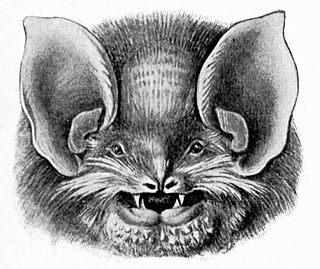
The spectral bat, also called the great false vampire bat, great spectral bat, American false vampire bat or Linnaeus's false vampire bat, is a large, carnivorous leaf-nosed bat found in Mexico, Central America, and South America. It is the only member of the genus Vampyrum; its closest living relative is the big-eared woolly bat. It is the largest bat species in the New World, as well as the largest carnivorous bat: its wingspan is 0.7–1.0 m (2.3–3.3 ft). It has a robust skull and teeth, with which it delivers a powerful bite to kill its prey. Birds are frequent prey items, though it may also consume rodents, insects, and other bats.

The Jamaican, common, or Mexican fruit bat is a frugivorous bat species native to the Neotropics.

The family Natalidae, or funnel-eared bats, are found from Mexico to Brazil and the Caribbean islands. The family has three genera, Chilonatalus, Natalus and Nyctiellus. They are slender bats with unusually long tails and, as their name suggests, funnel-shaped ears. They are small, at only 3.5 to 5.5 cm in length, with brown, grey, or reddish fur. Like many other bats, they are insectivorous, and roost in caves.

The big-eared woolly bat or (Peters's) woolly false vampire bat is a species of bat, belonging to the family Phyllostomidae.

Parnell's mustached bat is an insectivorous bat native to the Americas. It ranges from southern Sonora, Mexico, south to Brazil. It has a wider historical range; fossil specimens have been collected on the island of New Providence in the Bahamas.

The Mexican funnel-eared bat is a bat species. Despite its name, it is native to the Lesser Antilles in the Caribbean.

The little big-eared bat is a bat species in the order Chiroptera and family Phyllostomidae. It is from South and Central America particularly Colombia, Venezuela, Guyana, French Guiana, Brazil, Peru, Ecuador, Bolivia, Argentina, Paraguay, Suriname and Trinidad. Though its exact population is unknown, it is considered widespread and occurs in protected areas, although deforestation may be a minor threat, it is classified as Least Concern. It is found in multistratal evergreen forests and dry thorn forests and forages near streams and is found hollow trees, logs, caverns, or houses with groups up to twelve. The head and body length measures at 44 millimetres (1.7 in) for males and 45 millimetres (1.8 in) for females. Males usually weigh about 5 grams (0.18 oz) while females weigh 5.7 grams (0.20 oz).

The Mexican big-eared bat is a species of vesper bat endemic to Mexico. They are nocturnal and insectivorous. Their very large ears are located across their foreheads, and when captured, the bats are observed to curl their ears in a protective manner. The adults are usually brown colored, while the juveniles are usually a smokey brown color. They have small noses.

Rafinesque's big-eared bat, sometimes known as the southeastern big-eared bat, is a species of vesper bat native to the southeastern United States.

The long-eared myotis is a species of vesper bat in the suborder Microchiroptera. It can be found in western Canada, the western United States, and Baja California in Mexico.

The Cuban funnel-eared bat is a species of bat in the family Natalidae. It is one of two species within the genus Chilonatalus and is found only in the Caribbean.

The genus Chilonatalus of funnel-eared bats is found in South America and the Antilles. It has three species. New mitochondrial and nuclear DNA sequences that were analyzed with published morphological data to see the relationship of extinct natalids. It was found that this fossil taxon's phylogeny that was based on morphological data can be assumed that the Chilonatalus micropus is and one other species is a widespread species

Leach's single leaf bat, also known as Greater Antillean long-tongued bat, is a species of bat in the family Phyllostomidae. It is found in the southern Bahamas and in all the Greater Antilles. It forms large colonies, with up to a few hundred thousand individuals, and feeds on a relatively wide variety of food items including pollen, nectar, fruit and insects.

The genus Natalus of funnel-eared bats is found from Mexico to Brazil and the Caribbean islands. They are slender bats with unusually long tails and, as their name suggests, funnel-shaped ears. They are small, at only 3.5 to 5.5 cm in length, with brown, grey, yellow, or reddish fur. Their tail is completely enclosed in the interfemoral membrane. Adult males have a natalid organ, a large glad-like organ, on the muzzle or face. Their skulls are delicate and extended. They have swollen, rounded braincase and narrow, somewhat tubular rostrum. They have nineteen teeth on both sides, with two upper and three lower being incisors, one upper and lower canine, three upper and lower premolars, and three upper and lower molars. Like many other bats, they are insectivorous, and roost in caves. The genus is similar to the Furipteridae and Thyropteridae genera. All three genera have mostly the same geographic ranges.

Myotis septentrionalis, known as the northern long-eared bat or northern myotis, is a species of bat native to North America. There are no recognized subspecies. The northern long-eared bat is about 3–3.7 inches in length, with a wingspan of 9–10 inches. It is distinguishable by its long ears when comparing it to other bats in its genus. This species is commonly found in the northern United States and Southern Canada east of British Columbia. The geographic range includes 37 states.

The Hispaniolan greater funnel-eared bat is a funnel-eared bat species endemic to the island of Hispaniola in the Caribbean. First described in 1902, it has a complex taxonomic history, with some authors identifying multiple subspecies, now recognised as the separate species Natalus primus and Natalus jamaicensis, and others considering Natalus major to be itself a subspecies of Natalus stramineus. It lives primarily in caves and feeds on insects.

The Cuban greater funnel-eared bat is a species of funnel-eared bat. It is endemic to a cave in westernmost Cuba.

The Mexican greater funnel-eared bat is a species of bat found in Central America. While initially and currently described as a species, from 1959 to 2006 it was considered a subspecies of the Mexican funnel-eared bat, Natalus stramineus.
Chilonatalus macer is a species of bat endemic to Cuba.
















